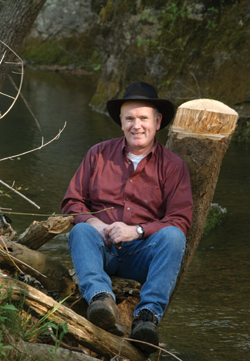
Vanderbilt Student Health Services Director John Greene, M.D., relaxes on his farm in Hickman County. Photo by Dana Johnson
The Students’ Doctor: John Greene teaches life’s lessons by example
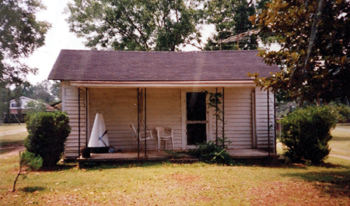
Greene’s childhood home in rural Barnesville, Ga. Photo courtesy John Greene
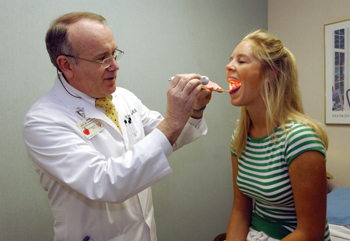
Greene examines a student patient, Ashley Huff, in the Student Health Clinic. She has been a patient of his for the past three years. Photo by Dana Johnson
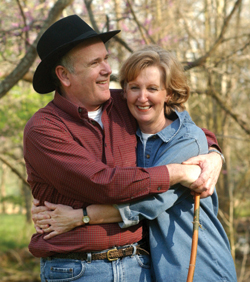
Greene hugs his wife of 37 years, Linda, on a day spent at their country home. Photo by Dana Johnson
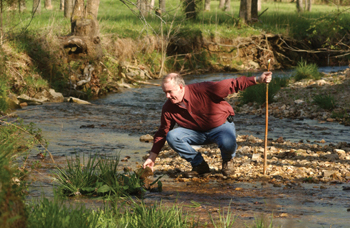
Watching the water go by, Greene enjoys spending time in the creek that runs through his property named Greene Ridge. Photo by Dana Johnson
Growing up, John Greene never planned on becoming a doctor. But one thing was clear — his goals extended beyond his hometown of Barnesville, Ga.
“No one said, ‘why don’t you be a doctor?’ No one said, ‘why don’t you achieve?’” Greene, director of Vanderbilt Student Health Services, says. “That’s the interesting part. It seemed that one day I came to realize that I enjoyed reading and learning, and making good grades became important to me.”
John Wayne Greene — his parents named him after the famous movie star — grew up in the country, the youngest of eight children on a farm without running water. His family grew corn, peas and watermelons and trucked them to town to sell. Greene’s mother worked as a bookkeeper and filled out income tax forms for about half of the residents of the small rural town, often charging only $1 each.
Each of his siblings quickly left home when they turned 18, either getting married or joining the military. No one expected that Greene’s departure would be for higher education.
“There were times that it felt that I didn’t fit very well into my family,” Greene says. “Growing up in the country, my father and brothers liked to hunt, fish and do those things you do in the country. But I was never very interested in those kinds of things. I enjoyed reading and really didn’t care much for guns or farm animals.”
Greene says he was always a sensitive person and never liked to see anything die, even the hen that was being killed for dinner; something he thinks led to his career in medicine.
“My uncle once told me that I always thought I knew why people did things or behaved in certain ways. One of my earliest interests in medicine was in psychology. It seemed that I tried to read people’s faces, trying to determine their needs. Everyone is born with personality traits and I just happened to be a sensitive child, I suppose,” he says.
Though he can’t pinpoint a time in his youth where he thought “that’s it, I’m going to be a doctor,” Greene can single out certain things that piqued his interest in medicine. Trying to figure out his father’s illness, for one.
“My dad had early Alzheimer’s disease and, well, I don’t think he knew me by the time I was 14 or 15. When you have Alzheimer’s, you think many people in your life at that time are from the past, so he would think I was his uncle John or his cousin Bob or someone else. So I found myself trying to figure out and cope with that process.
“I think part of my interest in going away to college was simply to move into a different environment. Not having the usual amenities, such as indoor plumbing, and living in a situation that was somewhat chaotic, I thought — this is not where I would like to be,” Greene says. “A part of my motivation to achieve was related to growing up very poor, and also wanting my mother to be happy that I was achieving. She worked very hard and was very industrious.
“But there was little indication that my parents felt that college was important. My mother was pleased that I was going, and I received a lot of encouragement and support from my older brothers and sisters. But with my father, I don’t think it even processed.”
Greene graduated from the State University of West Georgia, and in 1966, he went on to medical school at the Medical College of Georgia (MCG).
“MCG was the only medical school that I could afford. Since I was a resident of Georgia, the tuition was lower and the state provided very low interest loans. A private medical school or even an out-of-state school never crossed my mind. Certainly not a Vanderbilt,” Greene says.
Though Greene had left Barnesville, he had found someone who he certainly couldn’t leave behind.
“I met my wife [Linda] when she was only 13. And I, of course, was a rough and ready 16-year-old with a car — an old car, but a car,” Greene says. Linda was babysitting his brother’s children at the time. “She was too young to start dating at that time.” Greene was willing to wait. “There was just something about her that attracted me then and has ever since,” he says.
They married during Greene’s first year of medical school — now 37 years ago.
“It’s a long time to know someone, but in a very good way,” Greene says. “She says she takes up all the slack, and she does — whether it is managing our finances, doing our taxes or buying property.”
Together, they raised two sons — one an artist who lives in Nashville, the other a radio producer who lives in Atlanta.
“It’s interesting that my sons’ chosen vocations — art and entertainment — are in areas that we had always enjoyed together,” Greene reflects.
Linda, a graduate of David Lipscomb University, is also a top-notch cook, according Greene.
“I say that there’s no reason to eat out unless she wants a break from cooking. For my tastes no one cooks as well as she does. And that’s across the board. Anytime she wants to go out, we’ll go out, but I have never been to a restaurant that serves food that I like as well.”
Greene says Linda has always worked hard, even when it meant supporting the young couple as Greene went to medical school.
From a lab coat to Army fatigues
In order to support himself through college, Greene was enrolled in ROTC for the first two years. He knew that at some point he would have an obligation to serve his country. The year after he completed medical school, Greene was drafted.
Having grown up in Georgia and gone to college and medical school in Georgia, it would be natural to assume that being in the military would at least take Greene outside the borders of the Peach State. But it didn’t.
“I didn’t go too far. I went to Fort Benning, Ga. — the home of the infantry,” he says.
Greene served as a general medical officer for his two years of service. He says one of his most interesting experiences during that time was being the stockade surgeon.
“The general medical officers drew straws for the position. I lost and had to be stockade surgeon for six months, which primarily involves checking on the soldiers who are in the stockade,” Greene says. “One of the most interesting prisoners at that time was Lt. [William] Calley, the young lieutenant in charge of the platoon involved in the My Lai Massacre in Vietnam. “He was under house arrest at that time, so we went by every day to check on him,” Greene says.
It was also during his service in the military that Greene developed an interest in adolescent and young adult medicine. He was caring for young soldiers and their wives, most of whom were between 18 and 20 and were usually under a great deal of stress. Treating this age group would become his lifelong commitment.
Treating a new troop
Greene finally made his border-break, and came to Vanderbilt as a resident physician in pediatrics in 1973. The young physician and veteran thrived at Vanderbilt and was chief resident in 1975 and 1976. Georgia pulled him back for a year as assistant professor of the Ambulatory Division of the Medical College of Georgia, but he returned to Vanderbilt in 1977 as an assistant professor.
“I began developing an adolescent medicine program because there was not one at Vanderbilt and there were only a few in the country,” Greene says. In 1979, he became director of the Division of Adolescent Medicine and added the Student Health Center and Division of College Health/Young Adult Medicine to his plate in 1981.
“He founded adolescent medicine and has been committed to supporting and promoting it,” says Lynn Walker, Ph.D., director of the division of Adolescent Medicine and Behavioral Science. She has collaborated with Greene on research throughout the last 20 years. “Dr. Greene sees the strengths in adolescents — he realizes this is an important stage of life and has gone out of his way to provide the best service to this age group. He had a mission, and has worked hard to see it fulfilled.”
Greene remained director of both Adolescent Medicine and Student Health until 1995.
“When you’re 35, to hold both positions is fine. When you’re 45, it’s a challenge. When you’re 55, it can be painful. So I decided I could do only one or the other and do it well, so I moved exclusively to Student Health,” Greene says. But it wasn’t an easy decision.
“One of the reasons I stayed in Adolescent Medicine so long is because the kids I cared for in that practice had similar needs to those who I had known growing up in Georgia. I had the feeling: let’s see if I can help someone who was sort of in the same position I was at one time during my youth,” he says.
“I became interested in the age group thinking that maybe I could be a stabilizing force in some of their lives. I enjoyed helping young people. You know the saying that there may be a lot of darkness, but if we can light just one candle, we can make a difference. Let them know there is someone who will listen to their situation and will be an adult who doesn’t want anything from them and doesn’t expect anything from them, but who they can talk with and relate to.”
Greene has lit many candles during his career and continues to get calls, cards and letters from teen-agers that he took care of years ago.
“Dr. Greene can relate to all of the students — those with privilege and those without — and treats them all alike,” says Penny Meek, LPN, who has worked as Greene’s nurse in Student Health for two years. “He has a real rapport with the students. So many want him to be their primary care physician after graduating, but he can’t take any more — he already has 75 to 100 patients who are from his Adolescent Medicine practice or graduates.”
The secret is simplicity
Greene has a philosophy that he tries to live by and pass on to students: “Most things are very simple and straightforward, if we let them be.”
“Most problems have a logical sequence,” Greene says. “And if you approach them objectively, you can usually find a solution. The process doesn’t have to be difficult, but unspoken messages and emotions can get in the way.”
Take for instance one student who came into his office. She wasn’t eating because she was upset that her father wasn’t talking to her.
“I said, ‘Why don’t I just call your dad and tell him what you’re thinking and what he’s missing — you’re a very bright and nice young woman — why don’t I just tell him?’ She said, ‘You can’t do that — he’ll yell at you.’ I said, ‘Well, I’ve been yelled at several times today, one more time won’t matter.’
“So I called him and said, ‘Your daughter is here, and she looks like she’s having a really difficult time, and I think that it would help if you showed her some support by talking with her. She is having difficulty sorting out your silence.’ After not saying anything for [what seemed like] five minutes, he asked, ‘Well is she right there now?’ I said, ‘Yes, why don’t you just talk to her?’ And so he did, and after their relationship improved, she didn’t feel as responsible for the family conflict and began eating again.
“It’s not always that simple, but the phone call seemed to begin a process for restoring their relationship.”
“Dr. Greene is always a mentor — to any student,” says Meek. “He loves teaching and education is always there in any of his interactions with students. And he makes learning fun.”
“He has a great bedside manner and tries to be supportive, letting them know there’s someone who’s there if they need him,” says Earl Vastbinder, M.D., staff physician for Student Health Services. Vastbinder has worked side by side with Greene for nearly 20 years.
“He’s been named to the top doctors’ list several times. I would say it’s because he’s so committed. He loves the students and really has their loyalty,” Vastbinder says.
Shooting straight
Greene may have been predestined to stand strong and tell it like it is. Remember, he was named after John Wayne.
“If he seems easygoing, it’s probably because you feel so comfortable with him,” Meek says. “I wouldn’t say he’s easygoing though — I would say he’s fair-going. He’s very fair — you know where he stands. He shoots straight and puts everything on the table. But it’s his caring spirit that sets you at ease.”
Vastbinder agrees. “He’s straightforward, and some people don’t like that. He’s going to let you know if something goes wrong, but he’ll be fair about it.”
Greene is also known for going beyond the call of duty. According to Meek, he’s the first one in the ER if a co-workers’ family members is there.
Greene also plays Santa at the Student Health Christmas party. His co-workers said he sets their kids on his lap, writes down their names and asks them what they’re interested in. He gives them hugs — because “Santa really needs hugs.” And he brings them small gifts.
“Gifts he goes out and purchases himself — he doesn’t send a secretary to do it,” Meek says. “He’s not afraid to show his heart — and it’s a very kind heart.”
Back on the farm
In a demonstration of the powerful pull of one’s roots, the boy who wanted nothing more than to get away from that farm in Georgia now owns a farm — in Tennessee.
“It’s just some rural acreage,” Greene quickly points out, “but we fondly refer to it as a farm. We have 120 acres in Hickman County [about 45 minutes southeast of Nashville], which is very pretty country — its very country and pretty, too.”
With a house, a stream and a pond, five geese and two ducks, Greene enjoys sitting back and watching the stream go by. Though it’s a bit more work than he bargained for, Greene says country living is therapeutic for him.
“It’s a place to relax. The good thing about it is that if I move a rock to build a wall, it stays in place. If I plant a tree, it grows where it is planted. Whereas with patients, you can try to get them to come along or make progress, but they don’t always sustain their progress and sometimes they regress,” Greene explains.
“It’s a different kind of therapy — you can say ‘I just did that’ — the wall is built or the tree is planted. There’s an immediate gratification that when you build something, it’s going to be there.”
For a doctor who has taken care of a generation of teens who are now the parents of teens, who has seen his favorite artist, Neil Diamond, fall in popularity and rise again, and who has come from no running water to watching the water roll by, the stability of a rock staying in place is the perfect therapy.
As Greene would say — most things are very simple and straightforward, if you let them be. And he’s letting them be.













